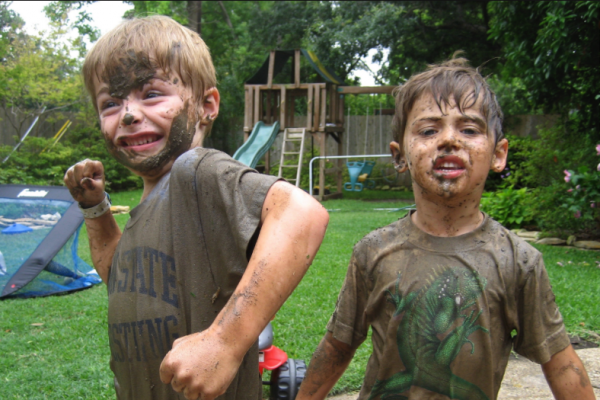
There’s Only One Method I’ve Discovered That Gets Kids To Listen The First Time Almost Every Time.
Parenting often feels like hostage negotiation with drunken, bipolar pirates.
When our kids run amok, many of us parents resort to either just giving in to their mutiny, or by bombing them with rage-driven cannon balls.
But there is a much better way.
As far as I know it is the only way to bring them in line so that they actually listen the first time, almost every time.
A disclaimer: I am not saying I use this method as consistently and completely as I could, but when my kids get into a pattern of persistent non-co-operation it’s not the fault of the method, it’s my fault for not using it properly.
So what is the method? There are 4 steps…
- Step 1: Give the instruction once in a non-threatening tone, followed by a happy ‘Good listening!’ if they obey in 3 seconds.
- Step 2: If they don’t, say ‘You’re not listening!’ in a firm tone.
- Step 3: If, after another 3 seconds, they still don’t obey, say, ‘You didn’t listen!’ and execute the consequence.
- Step 4: After the consequence, see if they’re ready to listen / make right what they did wrong. If not, the consequence continues or repeats.
I can’t believe I just shared that with you for free!
When I think how badly us parents need to know these steps, and how rarely this magic formula is revealed to the masses of desperate parents, I could make a million bucks selling it to people. (I read over twenty books on the subject and didn’t find it in any of them.)
Let me back up for a while before I unpack those 4 steps…
I am not saying that we perpetually use a command-mode of parenting.
As I showed in previous posts (here and here), I am not a defender of old-school parenting which only operates in an authoritarian mode. There are many times in a day when it is better to be a pied-piper who herds your child in a direction, than a pants-wearer who commands them.
But I don’t support the modern trend in parenting to never take charge and be in control of our kids. As Brene Brown puts it, ‘The job of children is to test boundaries. The job of parents is to uphold those boundaries.’
If we fail to assume and assert authority over them, our kids will constantly exhaust and frustrate us and themselves. They will undermine the sanity and stability that a family can otherwise bring to everyone in it.
But how do we control our kids in a fair and consistent way?
Without needing to beg, or threaten, or repeat our instructions with a louder voice, or snap in anger?
Julie and I know of only ONE way to consistently bring them under our reins. I wish I could say that we found it through sheer experimentation.
We didn’t.
A few months ago, we finally humbled ourselves and paid a recommended parenting coach to come for a home visit. What Celeste Rushby taught us that day was not all entirely new to us. But what was new is that she:
- provided a few missing critical pieces.
- gave us the correct combination and sequence of pieces. I couldn’t solve the Rubik cube till someone gave me the formula. In the same way, I couldn’t consistently control my kid till she shared the formula with us.
- challenged something I’ve incorrectly believed, namely that we can’t possibly expect small kids to always obey us straight away – after we’ve given just one instruction. (How wrong was I!)
The 4 steps may seem so obvious as you read them, but after reading so many books on the subject of getting our kids to listen to us, none of them gave us anything that was even remotely this effective, never mind as simple.
The result of the coach’s intervention?
Some immediate aha moments. Like Charlie not whining for 24 hours straight the first time we implemented her wisdom. (We had no idea that his grumpiness could be significantly reduced by us merely telling him to stop grumbling.)
But long-term, Julie and I now look back on many months, with great patches of time where our kids were responsive to our instructions. Also, when we start to lose control (and we do often enough), we can quickly identify what we’re doing wrong as parents, and re-implement the 4-step plan that she gave us.
I have taken some of what Celeste taught us on that day, and reworded and reformatted it:
Before you can use this 4-step plan, you have to tell your kids the rules.
Just last night, I reminded my kids of the 4 rules: “There are 4 rules, which always, always lead to consequences if broken:
- Don’t damage things.
- Don’t hurt one another.
- Don’t endanger your life.
- Obey our instructions, first time we say them, and straight away.
Have you said words like that? Especially the last one?
Try it. Resist it as they might, kids thrive with boundaries.
I don’t know if they need more than these 4 though. (My kids insist one more rule should be added: ‘Don’t worship the devil.’ I have not added it yet, but I suppose if they start drawing pentagrams in their Kids Bible, I’ll certainly throw it in.)
By far, the most recurring rule to be tested will be the last one about obeying, first time and straight away. It is the most important of the 4 rules for 3 reasons:
- It is the rule for 1000 possible instructions.
- It is where the parent-child conflict tends to rage most fiercely. Win this battle, and you can win a 100 other battles.
- If abided by, family life can be a much happier space for all.
Once those 4 rules are clear in the minds of your children, you are ready for the 4 steps to reining them in.
Now, get this:
- If your child breaks rules 1-3 (damaging stuff, hurting others, endangering themselves) you go straight to step 3 and 4 below. You jump over step 1 and 2.
- If your child breaks rule 4, then all 4 steps apply.
Get it? Okay let’s dive into those steps…
Step 1: Give the instruction once in a non-threatening tone.
Whether it’s, ‘Put that down.’ ‘Come eat your food.’ ‘Come to the bathroom’ ‘Stop!’ ‘Stop shouting’ ‘Say hello to our guests’ ‘Climb in the car’ or ‘Get off my iPad,’ here are some tips to optimize the effectiveness of your instruction.
- Stay calm and upbeat as you give it. This communicates that obedience is normal, not an unfortunate invasion into their happiness.
- Give a clear and simple command. Saying, ‘Would you… ’ or ‘Can you…’ is suggestion not command.
- Put their name at the front of the command. ‘Ivy, climb in the car’. Sometimes, after their name, add the word ‘listen’ – the combo of the name and the verb communicate to your child that a directive is coming in for landing, such as, ‘Fynn, listen: let Sam sleep’.
- Say it in the simplest possible sentence. Don’t give 2 instructions back to back. And use short sentences with short words.
- Say it positively. ‘Shut the gate’ is better than ‘Don’t leave the gate open’. Say ‘Walk!’ instead of ‘No running’.
- If they’re absorbed in something, give them warning. For example if they’re playing with a toy, making a puzzle, or enjoying a bath, give them a minute warning. This is just being kind. Don’t you need more than a few seconds to change gear when you’re in the zone? Say, ‘In a minute, I want you to pass that toy to your sister’ or ‘In a minute I want you to climb off the trampoline.’ With smaller kids, I find it helpful, when there are 10 seconds left, to loudly count-down from 10 to 1. Perhaps even encourage them to count-down with you: ’10, 9, 8, get ready to pass the toy, 7, 6, 5, 4, 3, 2, 1.’
If they obey in 3 seconds, say ‘Good listening!’ in a delighted tone. One of the secrets to guiding the behaviour of people is to heap appreciation on good behaviour every time you encounter it. Most little kids want to please their parents, and your praise is like sunshine and water on the small plant of obedience growing in them – helping it to take even deeper root in them.
But what if they don’t listen in 3 seconds?
Step 2: If they don’t obey within 3 seconds, say ‘You’re not listening!’ in a firm tone.
Before Celeste taught us this, we would go wrong at this point. We’d give the command. They wouldn’t listen and then we would stupidly (while masking our panic)…
- repeat the command, each time with a little more volume and frustration in our voice,
- negotiate with them (‘You can have desert if you do’),
- threaten them (‘You want have any desert if you don’t!’), or
- manipulate them (‘Don’t make mommy upset!’), or if these fail,
- lose it (‘ARE YOU DEAF!? PUT THE FREAKING JUICE DOWWWWWN!’)
These are all rookie errors.
All we’re doing is clumsily teaching them to ignore our first command, and instead to learn to predict our snapping point, and then to obey us seconds before they think we will.
A much better way is to not get emotional at all.
Read that last sentence again.
The way to do this is give the instruction once and calmly, then to count to 3 under your breath, and say with a measure of firmness, ‘You’re NOT listening!’
In my house, when we have been applying these steps, there are no more powerful words to galvanize immediate co-operation than, ‘You’re not listening!’ You should see it, most times my kids spin their heads in attention – whether they are 2 or 9. If there was any doubt in their minds that I meant business, these words let them know that I am in wear-the-pants mode.
If they do obey you, you can stop right there and flick back to praise mode. Your child is being respectful once again.
But what if they don’t (and they won’t the first few times you go through these steps)? Then things get serious, and steps 3 and 4 kick in.
Step 3: If, after another 3 seconds, they still don’t obey, say, ‘You didn’t listen!’ and execute the consequence.
So you have given the command, waited 3 seconds, then said, ‘You’re not listening’ and then waited another 3 seconds with no observable obedience in that time. Bring on step 3.
‘You didn’t listen!’ – The words must be spoken in a firm, calm, non-spiteful and non-angry way.
When it comes to this step, you have to wear the pants by executing a consequence. You cannot let them get away with it.
Not even once.
They must come to believe that always – always! – the words ‘You’re not listening!’ will be followed by an undesirable outcome if they don’t act within 3 seconds!
The only way step 3 – ‘You’re not listening!’ – will work is that they know from experience that you are not a push-over.
A bit about consequences: After you have uttered the dreaded words, they might apologize and try to obey you. But it’s too late. They missed their 6 seconds of grace! A consequence will now ensue.
A consequence is not a punishment angrily unleashed by a frustrated parent. That’s emotional abuse. In fact, the words ‘Oh no – look where disobedience gets you’ are far more suited to the discipline moment than ‘How dare you – I’ll show you!’
In other words expressing pity is more effective than anger. Assigning a consequence teaches them that us parents don’t just have a voice, we have authority. When done right it forces reflection on what they did wrong, and gives them a chance to rethink and amend their ways.
But what consequence should be assigned?
It’s a subject on its own. But if you must know, we have found that by far, the best consequence is an immediate time-out that works like this:
- We say, ‘Time out – go to the bathroom (or wherever you designate)’
- If they don’t immediately go on their own, we walk or carry them there. We remain calm, and sometimes say, ‘Oh no! Look where your not listening has got you.’
- The door does not need to be closed.
- If they won’t stay in the time-out place, we threaten to close the door on them so that they will. (I promise, I love my kids by the way. Julie and I literally needed a parent coach to help us shake off our softness so that we could learn to follow through on this part. Once they had experienced the closed door consequence, none of them tried to leave time-out again.)
- We assign them a minute per age in years; 3 minutes for 3 year olds for example.
- If they cry or scream while going there or while there, we don’t stop them from doing so.
- In one case, when one of our children seemed to be particularly freaked out by being alone in the bathroom, or by the imagined feeling of parental rejection, we held our line, but in the most caring way we could, ‘You’re staying in time-out for not listening, but if you’re scared, I can stay here with you, but not to talk or cuddle or play.’ (Us parents in a therapeutic age are all worried we’re going to somehow psychologically damage our kids, hey?)
Time-outs work especially well for ages 2-6. They do work with older kids too, but generally kids who are 7 and older require more complicated consequences.
Step 4: After the consequence, see if they’re ready to listen / make right what they did wrong.
Consequence complete, ask them, ‘Are you ready to listen?’
Or if they broke rules 1-2 (don’t hurt another or damage things) ask something that helps them make amends, like, ‘Are you ready to…
- help me pick up and throw away the pieces of the plate you just threw on the ground?
- ask your brother’s forgiveness for hitting him?
If they say yes then say, ‘Well done’ and take them by the hand. If they don’t say yes, calmly say, ‘Oh no! You haven’t learned your lesson yet’ and continue or repeat the consequence.
A bit about empathy: If your child looks aggrieved, you might need to do some listening at this point. Your kid might be convinced their original action was justified (‘She pushed me first!’) and hence feel mistreated by the fact that they were sent to time-out.
If so, don’t get into an argument with them. Rather acknowledge their feelings, but stick to your guns. Say, ‘I can understand how you felt irritated / sad / angry. We can talk about that some more. But no matter how you feel, if you break things / hurt another / endanger your life / disobey me, there’s always a consequence.’
A bit about getting it right: don’t miss the chance to help them obey in the area where they had just disobeyed. Kids don’t only learn from consequences when they get it wrong – more significantly they learn from getting it right. For example…
- If they had hurt their sibling, if they don’t genuinely ask for forgiveness (even though they had moments before agreed to do so) say, ‘I don’t think you meant that. Back to time-out.’
- If they had refused to give you the scissors, put the scissors back in their hands, and ask for them once again. When they do it right, say, ‘Good listening!’
- If they smashed the plant on the floor, I hope you didn’t pack it away while they were in time-out. No, they must help you pick it up. Failure to do so means another consequence.
This is what we found as we implemented these steps.
At first it came as a shock to our kids. But after a few time-outs they came to recognize and respond to step 1 and 2. It began to feel great for Julie and I to finally have the reins on these pirates.
But then after a few days or weeks, they would try push us again to see if these steps were still in place. We would have to rise to the moment, and follow through with steps 3-4. And order would ensue once again.
A recap of the 4 Steps
I said a lot I know, but what you need to remember to bring your kids under your control is this (assuming you have told them the 4 rules):
- Step 1: Give the instruction once in a non-threatening tone, followed by a happy ‘Good listening!’ if they obey in 3 seconds.
- Step 2: If they don’t, say ‘You’re not listening!’ in a firm tone.
- Step 3: If, after another 3 seconds, they still don’t obey, say, ‘You didn’t listen!’ and execute the consequence.
- Step 4: After the consequence, see if they’re ready to listen / make right what they did wrong. If not, the consequence continues or repeats.
That’s it.
Try it.
But do it properly. I haven’t wasted a line in this post. From my experience, you need almost every line of insight in this post to make it work properly.
Finally, I must issue 3 disclaimers…
First disclaimer: it’s so simple, yet so hard, I know.
I can imagine some of you skeptically saying, ‘If only it were so simple and easy.’
My answer: it is that simple! But you’re right, it’s not that easy. It’s actually hard work to do these steps (especially steps 3 and 4) and to keep it up.
Especially when you have strong-willed kids.
To be honest, during the last 2 hours of the evening, Julie and I often slip into less effective ways of getting our kids to co-operate. For example, trying to do a time-out just while we’re about to sit down for dinner for example just seems too exhausting.
But we have found that if we do not follow through with the consequence that the next day, we have to start again in training our kids to obey. On our better nights, we don’t let go of the reins. And we’re all glad for it the next day.
There are times when we forget these steps and resort to old rookie errors like shouting at or threatening our kids.
But the fact that both Julie and I had agreed to the 4 steps meant we could gently correct each other in that moment, with the words, ‘Use the 4 steps rather, baby.’
A few months ago, I went overseas. One of my parting gifts to my wife was to write up the 4 steps on the kitchen chalkboard so that, for her sanity’s sake, she wouldn’t forget to do them.
Second disclaimer: this works well at home, but not so well out of the home.
How do you issue a consequence in a restaurant, or at someone else’s home.
It’s not easy, because where do you execute the consequence?
To be honest, Julie and have mainly let the disobedience slide without a consequence. I don’t believe consequences that are delayed many hours after the disobedience are effective, especially in younger kids.
The only workable solution is to create a make-do time-out. I remember Julie making Sam sit with his face to a tree, while she stood back to his back. It was a mission for her to leave the table and do this, but it meant that our kids were more co-operative the rest of our time there.
Third disclaimer: you might still need your parenting coach.
When your kids are out of control, you might need more than the correct information I have tried to provide here.
Like us, you might need someone to hands-on coach you, and actually walk you through some trial runs like Celeste did for us.
In that case, swallow your pride, and get a coach to come into your home and walk you through the steps. We aren’t sorry we did.
Comments
Also published on Medium.




